Choosing the right tables for your restaurant is a key factor in its success. It is crucial to know how materials compare in durability, looks, and price. To determine which material works best for your tables, you need to know the type of materials, the composition, aesthetics, and functionality.
Top Tips for Choosing the Best Material for Restaurant Tables

Table top materials can be generally divided into 3 main sections - Solid Wood, Laminate, and Outdoor Table Materials:
Solid Wood:
There are many types of wood to choose from for your restaurant table. Each type of wood has different aesthetic and functional qualities. Some types of wood also have certain advantages over others. There are some types of wood that are more scratch resistant, stain resistant and heat resistant. Solid wood can be divided into 2 main categories - hardwood and softwood.
Hardwood provides elegance to the table whereas softwood makes the table more rustic and economical. Softwood is lightweight and comes from coniferous trees and has lighter shades and hardwood originates from deciduous trees and are comparatively darker in color.
A dining table is typically the focal point of every restaurant so naturally you would be looking for restaurant tables that are mostly made of hardwood. Hardwood is commonly used in most commercial tops because they are more resistant to wear and tear and last longer.
Which Species of Wood is the Best?
Although the cost is slightly higher, you get much more value from hardwood, both for aesthetics and durability. Maple resembles the look of cherry and can be found growing in the US, so it can be locally sourced. It can be stained in numerous colors. The graining of maple is more subtle. Beechwood, which is also a hardwood is one of the most durable woods used to manufacture furniture. Other good hardwood choices include walnut, which is also grown in the United States, is very durable and is highly sought after for fine furniture because of its beauty and can be used for any look. Oak is a very strong wood and is very decay resistant. Its bucolic look is great for rustic themed decor. All hardwoods are unique and beautiful in style and appearance. Each piece is crafted, stained and finished to express the character of your restaurant table and represent your venue’s concept. especially when matched with similarly finished wood restaurant chairs.
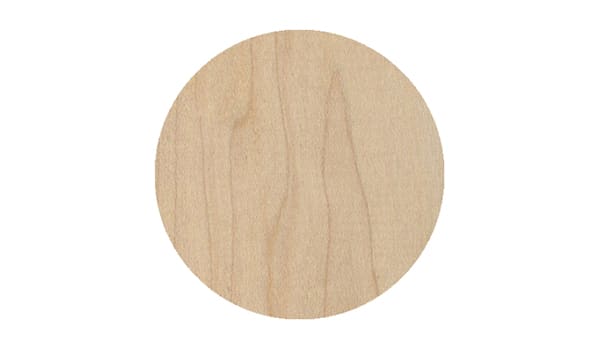
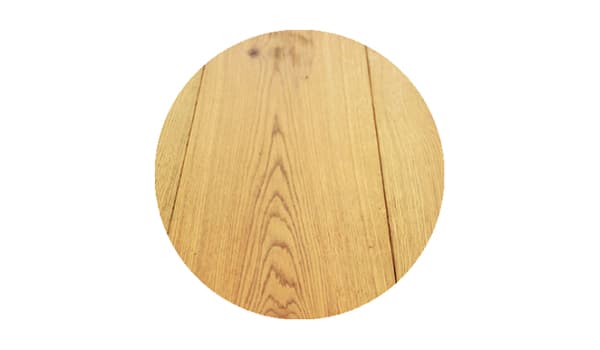
Oak

Walnut
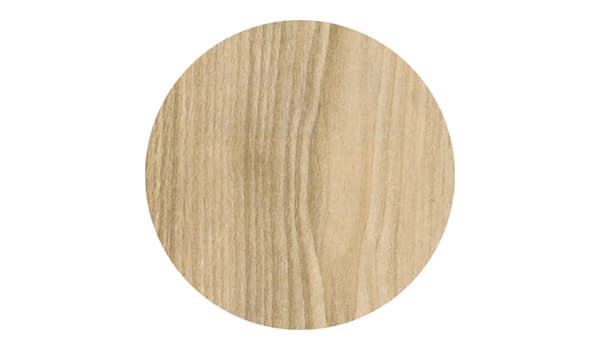
Beechwood
Types of Solid Wood Tables
In addition to their inbuilt strength, solid wood tops have a superior aesthetics and a natural look that is sought after especially in high-end dining establishments. The two most popular types are the plank and butcher block table tops.
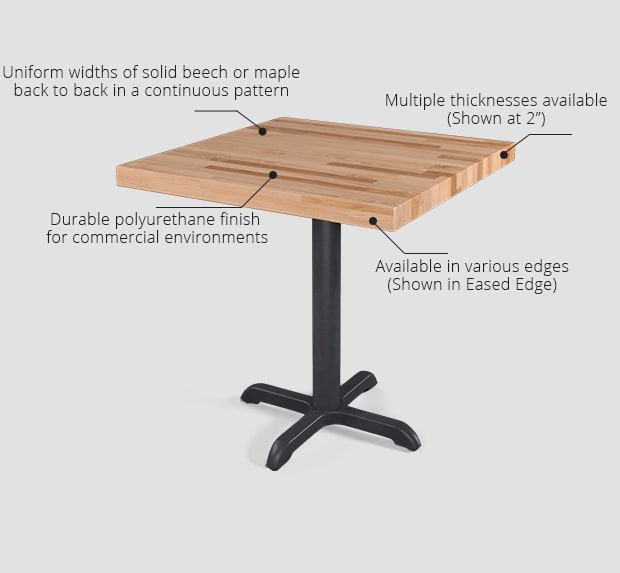
Butcher Block Table Tops
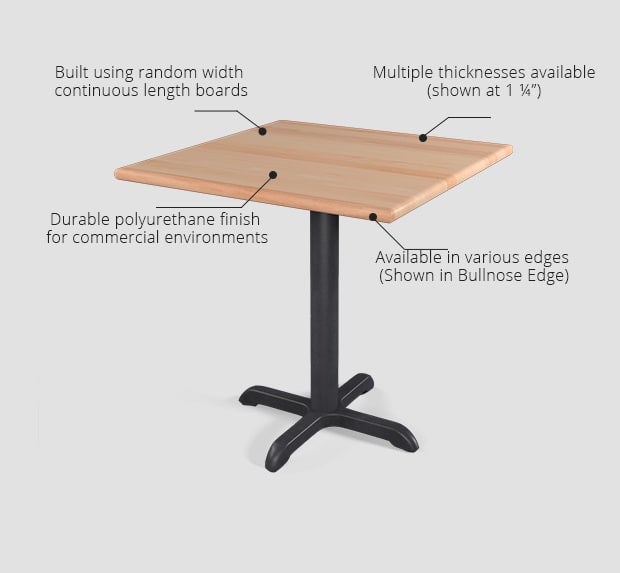
Plank Table Tops
Solid Wood vs Veneer
Solid wood and veneer table tops have many appealing attributes for those who are looking for a refined look for their venue. We sell only premium quality solid wood table tops that can be customized in any shape, size, shape or finish. Solid wood and veneer tops each have distinct characteristics, and each has its own benefits.
Both solid wood and veneer wood have their advantages and disadvantages. Choosing the right type of wood depends on how you plan to use it and what your priorities are. Constructed by bonding thin slices of hardwood veneer is an inexpensive alternative to solid wood and often has an attractive hardwood like mahogany on the exterior. Thus veneer can be an excellent way to have the appearance of expensive hardwood furniture without the high price tag.
Pros of Solid Wood:
Solid wood has the advantage of being more dense and sturdy than veneer, so it can handle more weight. It is also less susceptible to scratching and moisture damage than veneer.
- Classic aesthetics: Solid wood adds prestige to your venue. Its natural beauty will complement any decor and will fit in with a wide range of styles.
- Natural: Solid wood is natural and is not made of heavily processed materials with chemicals like veneer or laminate.
- Character: Solid wood comes from harvested wood sources rather than being manufactured with machine specs. To create a uniform look meaning no two pieces are exactly alike.
- Versatility: Solid wood comes in a variety of wood types with many different finish options, meaning you can have a custom finish made to match your decor.
- Increased Value: Solid wood furniture retains its value better over time compared to veneer.
- Restoration Potential: If solid wood gets damaged, scratched or dinged it can be fixed, or you can paint or stain it. You cannot do this with veneer.
Pros of Veneer:
- Moderate Price Point: While the cost is usually higher when compared to laminate, veneer is much more affordable than solid wood.
- Authentic Look: Veneer uses a thin layer of real wood which is made to look as close to real wood as you can get with non-solid wood.
- Uniformity: Since veneer is a manufactured product instead of harvested from wood it gives the pieces a more uniform appearance.
- Warp-Resistant - Table tops made of wood veneer resist warping better than solid wood.
- Lightweight Construction: The core of veneer tables is made of lightweight materials such as MDF and particle board. These materials are lighter than solid wood making the furniture lighter for moving around.
- Refinishing Options: Since the outer layer of veneer is made from real wood, it can be refinished to look like solid wood.
Laminate:
Laminate is a good choice for table tops if you want to save money and have more options to customize your table. Laminate is made of synthetic materials to form a thin layer that can look like wood, marble, stone or a uniform solid color. Laminate is made to be heat and scratch resistant making it an ideal material for use in the food service industry where scratches are common and hot items are placed on tables.
Not to be mistaken with melamine which is a lower grade for residential use material, laminate is perfect for commercial use made up of synthetic materials encased in a thin protective layer that can be made to look like wood or any other custom surface. Laminate is more affordable than solid wood and there are many ways to customize it to match your decor. It is very durable and is more heat and scratch resistant than wood making it ideal for a heavy traffic environment. Laminate is also easy to clean and maintain and is more hygienic than some other surfaces. The nice thing about laminate is that the top can look like anything. From wood to stone and even printed images, words and other textures.
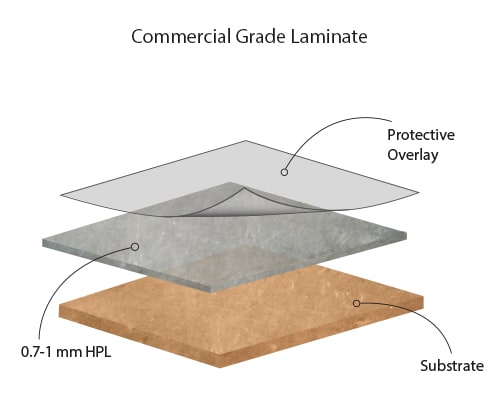

Pros of Laminate:
- Cost: Laminate is generally less expensive than other materials
- Easy to Clean: Laminate table tops are easy to clean and maintain. They are less absorbent than solid wood making them more stain resistant and hygienic.
- Durability: Laminate is a very durable material, making it a great material for the restaurant industry
- Low Maintenance: Laminate requires little maintenance and doesn’t require any special cleaners or polishes.
- Easily customizable: The top layer can be made to look like anything turning the top into a virtual canvass for even your wildest decoration.
Patio Table Tops - Outdoor Table Materials:
When shopping for patio furniture, due to exposure to the elements, you need outdoor tops that will be waterproof, rust-proof and UV resistant. Two popular table top materials that are ideal for patio use are plastic teak and Werzalit. Both are fully waterproof and are resistant to fading due from the harsh UV rays.
Plastic teak is a revolutionary material that has the look and feel of real teak but is environmentally friendly. Originally designed for marine use it’s 100% waterproof and UV resistant. Werzalit is also made from an advanced synthetic material that can be made to look like a variety of materials, from wood to marble and even printed images and text. Just like wood and like plastic teak, Werzalit is waterproof, UV resistant and scratch-proof.
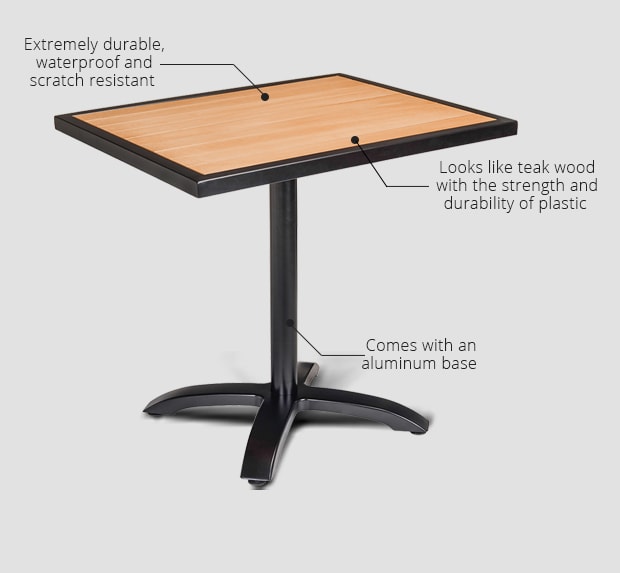
Faux Teak Table Set
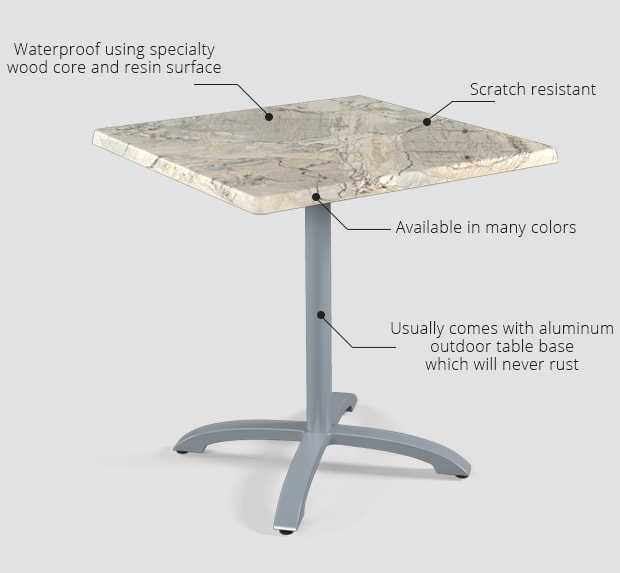
Werzalit Table Tops
Pros of Plastic Teak:
- Waterproof: Plastic teak is fully waterproof, It can be left out in the rain and will not be damaged by water. Also it will not crack or warp.
- Stain Resistant: The surface will not get stained if you spill coffee, wine or any other liquid or food.
- UV Fade Resistant: No matter how long it is left out in the sun, Plastic Teak will last for many years without fading.
- Scratch Resistant: The surface is scratch resistant, idea for commercial use.
- Easy to Maintain: Plastic Teak has the same durability, beauty and comfort of teak with a fraction of the maintenance. It can be easily cleaned without and special cleansers making it very hygienic. Unlike teak it doesn’t need to be varnished.
- Cools down faster: Plastic teak cools down 5 minutes faster than teak, which can make a difference for the comfort of your guests on hot days.
- Environmentally Friendly: Teak isn’t good from a sustainability perspective & is considered a "high risk" timber. No logging in tropical forests is required to make plastic teak as it is fully made of recycled materials.
Pros of Werzalit:
- Waterproof: Werzalit is waterproof, weatherproof material making it great for patios and outdoor use, Unlike wood, water has no effect on it and it will not warp or crack.
- Impact resistant: Werzalit can take any abuse whether an object falls on it, if it’s knocked over it won’t dent or shows signs of any damage.
- Scratch resistant : The surface is fully scratch resistant and can take any rough treatment.
- Heat & Burn Resistant: The surface can withstand heat upto 356F without getting burned and will not show burn marks from cigarettes or hot plates.
- Comes in Many Finishes: Werzalit can be made to look like wood, stone or any other surface. It can be made in many colors and styles.
- Durable & Lightweight: This robust material is very strong and lightweight, with the benefit.
- Easy-Care Surface: Werzalit is easy to clean and maintain, making it a hygienic surface.It doesn’t require any special cleaners.
- Proven Track Record: Werzalit has been in production for over 90 years,so it has been proven as a quality material.
To summarize: Both are made from advanced synthetic materials that are well-suited for outdoor use, both are fully weather-proof and scratch resistant. Werzalit is a slightly tougher material and there are more textures and surfaces to choose from such as wood, stone and other colors, whereas plastic teak is mainly if you are just looking for a teak alternative. An added advantage to plastic teak table tops is that they can be paired with many of our plastic teak chairs.






























































